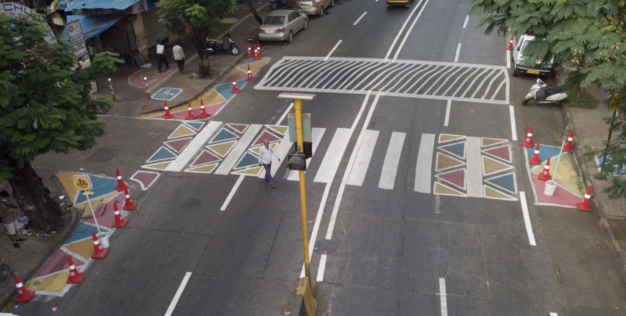
India has the highest number of road accident fatalities – but one man’s determination has reduced that figure by 40%. Here’s how:
“Road crashes take 1.35 million lives each year around the world. And 93% of these fatalities are concentrated in low- and middle-income countries like India.”
These are the words of entrepreneur and World Economic Forum Young Global Leader Piyush Tewari, who in 2008 founded the SaveLIFE Foundation following the death of a family member in a traffic accident, with the aim of improving the safety of India’s roads.
There were more than 155,600 fatalities on India’s roads in 2021, according to the country’s National Crime Records Bureau.
The SaveLIFE Foundation was behind the first Good Samaritan law in India, rewarding bystanders of road accidents. They also developed ‘green safety corridors’ using examples from busy intersections around the world, which have saved numerous lives. Here, Tewari speaks about his road safety crusade and how it is saving lives.
Why is road safety such a personal issue for you?
“India universally has the highest number of road fatalities, at 250,000 deaths a year. And I’m not new to the issue because my family has also suffered quite directly.
“That’s the reason why I founded SaveLIFE Foundation in the first place, to address the issue and try and find some solutions to be able to save lives on our roads and hopefully, expand that effort to other countries and other communities facing similar challenges.”
What reaction did you get when you began taking action to improve road safety in India?
“When I started SaveLIFE Foundation back in 2008, the issue was not among the top public health issues as far as public conversation and discourse was concerned.
“It took some effort to make people realise that almost every single road crash is preventable. It is not an output of development, it is a public health issue because injury is something that impacts not just individuals, but society as a whole, by taking away productivity, pushing families back into poverty and so on.
“The moment we accept a problem as the result of fate or something that had to happen as an acceptable output of something, we stop finding solutions. In my case, it was very important to change the discourse, to mainstream the issue and to come up with solutions that are not only acceptable, but replicable and scalable so they can be applied in various settings, both in India and outside Asia.”
How are accidents and deaths preventable?
“The reason I say that road crashes are preventable is because every single crash involves three elements. It involves a driver, it involves a vehicle, it involves the road infrastructure.
“In many cases, when SaveLIFE Foundation investigates road crashes, we are able to uncover the contributing factor that led to the crash and the contributing factors that led to injury in the crash. And both are often not the same.
“The crash may happen because of human error, but the injury might happen because of exposed infrastructure or an unsafe vehicle.
“Beyond the crash itself, the aspect of trauma care plays a critical role. And in low- and middle-income countries, the aspect of emergency medical care or trauma care is not very well established.
“So the idea of saving lives is to establish a chain of survival that starts with taking as much preventive action as we can by fixing infrastructure, creating safer vehicles, and providing pedestrian facilities. But also in the unfortunate event that a crash occurs, having really competent trauma care so that precious life can be saved.

The Good Samaritan law encourages onlookers to help those involved in traffic accidents. Image: REUTERS/Francis Mascarenhas
What are the main achievements of the SaveLIFE Foundation’s work?
“My foundation is best known for getting India its first kind of Good Samaritan law.
“Traditionally after a crash, people were hesitant to help an injured person on the road, out of fear of getting involved in a legal or procedural hassle. Sometimes even being implicated for that particular crash.
“Our work on the Good Samaritan law was focused on creating a conducive environment for people to come forward and assist the injured person. And by assistance I mean something as simple as making a phone call for help, which earlier people were afraid to do.
“And that environment manifested itself into a law that was first instituted by India’s Supreme Court and then passed by the Indian Parliament.
“We are also responsible for drafting a large part of India’s current road safety legislation, which was passed in 2019.
“And we are known for our work creating zero fatality corridors, where we adopt some of the deadliest roads in the country, and in partnership and close collaboration with government, academia and industry, carry out a concerted effort to transform these roads into safe corridors. Our goal is that by 2030 we will deliver a 50% reduction in deaths on India’s roads.
Has the foundation changed how road safety is viewed?
“Traditionally, the system of holding Good Samaritans or detaining them, or sometimes blaming them for an incident, is what led people to hesitate from helping an injured person.
“The Good Samaritan law has changed that. From a culture of not helping road crash victims over decades to now, shifting the culture to assisting victims and helping save their lives, I think that’s something that’s been transformational.
“Even I feel more confident. I had my hesitations previously because of the long-drawn-out legal processes that could last decades, for example. But it gives a lot of confidence to people.
“It’s been an integral part of our approach to drive social and cultural change.
“How do you tell 1.4 billion people in a cost-effective manner that they have a new right, that they are protected, that they are insulated, that their decades-long hesitations can be overcome?
“So the communication piece, the taking the message out piece, is something that is crucial for us. And that’s where I think our work with the World Economic Forum and other agencies in spreading the word, is crucial in letting people know what this impact looks like.
How does India’s updated road safety legislation make the country’s roads safer?
“The most significant aspect of India’s road safety legislation of 2019, called the Motor Vehicle Amendment Act, is that it is the first major amendment of the law since 1988.
“India’s economic development started in 1991, so the law predates that. The kind of roads that were created, the introduction of new vehicles, the technologies; the previous law did not account for any of that.
Most laws, and especially a law like this, needs to have at its very core, preservation of life as the primary driving factor
“It failed to create provisions that would enable children to commute safely on our roads, for example. So the big thing that’s come up in the new law is that children now have wide-ranging protections for the first time.
“The new law also mandates scientific investigation of crashes to allow the police and the authorities to understand what went wrong in a particular scenario. And the law also creates an enabling environment to introduce new technologies, both for enforcement and behavioural changes.
“Finally, for people injured in road crashes, the law provides for the creation of schemes to provide them immediate medical care. And this is a big part of the challenge in India, because not everybody has insurance, not everybody can afford high-end trauma care.
What are zero fatality corridors and how do they work?
“SaveLIFE Foundation’s zero fatality corridor programme takes a 360-degree approach to solving the problem. We have traffic intersections that are not designed for pedestrians and cyclists, but a heavy flow of cyclists use those intersections and they’re exposed in the process, for example.
“One of the solutions we use is tactical urbanism trials, where we use a redesign philosophy to re-imagine how an intersection could look for a child. And the moment you make a space safe for a child, you automatically make it safe for everyone.
“We are able to show how redesigning this particular space, whether it’s an intersection or a bridge or a stretch of road, can help save lives. And then we advocate for the government to make those changes permanent.
“The interesting thing about this entire approach is that it uses cultural empathy as the driving factor.
“Tactical urbanism trials were first done in the West to transform Times Square [in New York, US] into a pedestrian-friendly space, for example. We have picked up that concept and applied it to some of the most rural areas in India to preserve the lives of people navigating those dangerous intersections.
“The zero fatality corridor solution has so far delivered a 40 per cent reduction in deaths on average, on the roads that we are currently implementing it on.
“We have recently partnered with the government of India to scale the effort to 100 national highways, in 100 districts across the country, so that we can deliver our objective of reducing deaths nationally by 50 per cent by 2030.”
Republished from the World Economic Forum in accordance with Creative Commons Licensing.




